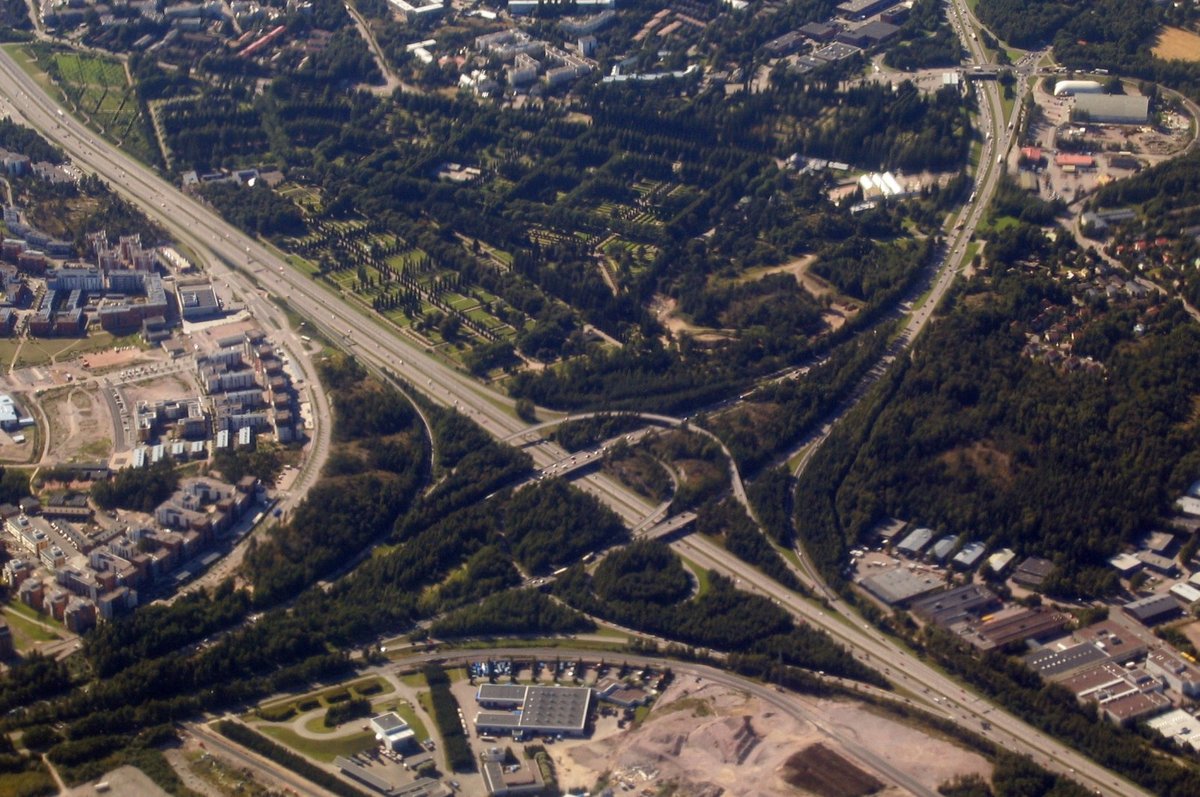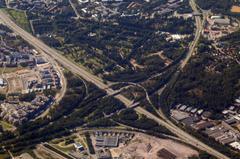
Malmi Cemetery Visiting Hours, Tickets, and Guide to Helsinki Historical Sites
Date: 14/06/2025
Introduction
Malmi Cemetery (Finnish: Malmin hautausmaa; Swedish: Malms begravningsplats) stands as Helsinki’s largest and one of Finland’s most historically and culturally significant cemeteries. Established in 1894, it reflects the city’s urban expansion and serves as the final resting place for over 200,000 individuals, including prominent Finns such as actors Tauno Palo and Ansa Ikonen, Winter War hero Captain Aarne Juutilainen, and musician Alexi Laiho. Beyond burials, the cemetery is a showcase of architectural heritage—featuring chapels by Selim A. Lindqvist, a protected 1930s water tower, and tranquil, park-like grounds.
Open to the public year-round with free admission, Malmi Cemetery welcomes visitors seeking historical insight, peaceful reflection, or architectural appreciation. This guide provides comprehensive details on visiting hours, admission, access, historical context, architectural features, and visitor etiquette. For further planning, consult the Helsinki Parish Association, Helsinki City, and Wikiwand.
Table of Contents
- Introduction
- Historical Overview
- Visitor Information
- Cemetery Layout and Architecture
- Landscape and Amenities
- Getting There and Accessibility
- Etiquette and Cultural Considerations
- Guided Tours and Events
- Nearby Attractions
- Frequently Asked Questions (FAQ)
- Summary and Call to Action
- References
Historical Overview
Origins and Early Development
Founded in 1894 to relieve the burden on Helsinki’s older graveyards, Malmi Cemetery was developed on land previously used as a military training ground. The cemetery’s establishment coincided with the city’s rapid growth and was designed to accommodate the needs of a diverse and expanding population (Wikiwand).
The Funeral Train
A unique chapter in Malmi’s history was the funeral train service, which operated from 1895 to 1954. Connecting Malmi railway station directly with the cemetery, it transported coffins and mourners, symbolizing the modernization and urbanization of Helsinki at the turn of the 20th century (Wikiwand).
Expansion and Cultural Significance
Over time, Malmi Cemetery expanded to cover approximately 65 hectares—of which 54 hectares are dedicated burial grounds. It houses around 50,000 graves and has seen more than 200,000 burials. The cemetery features both private and communal sections, including the Åberg Cemetery and areas dedicated to war heroes, reflecting Finland’s multi-denominational and multicultural fabric (Wikiwand).
Notable Burials
Among the cemetery’s most visited graves are those of actors Tauno Palo and Ansa Ikonen, singer Olavi Virta, designer Birger Kaipiainen, and Alexi Laiho of Children of Bodom. The burial sites of military heroes and cultural icons provide a tangible link to Finnish history (Wikiwand; Blabbermouth).
Visitor Information
Visiting Hours
- Summer (May–September): 8:00 AM – 8:00 PM
- Winter (October–April): 8:00 AM – 6:00 PM
Hours may be adjusted on public holidays. Always consult the official Helsinki city website before your visit.
Admission and Tickets
Entry to Malmi Cemetery is free for all visitors. No ticket or prior booking is required.
Accessibility and Facilities
- Wheelchair Accessible: Level, paved paths throughout.
- Restrooms: Available near main entrances.
- Water Points: For flower arrangements, located along main avenues.
- Benches & Shelters: Scattered throughout for rest and contemplation.
- No On-site Cafés: Food and drink options are available in the nearby Malmi district (Helsinki Urban Environment).
Cemetery Layout and Architecture
Spatial Organization
Malmi Cemetery is divided into sections for traditional burials, urn fields, war graves, and memorial areas. Its wide, tree-lined avenues and gently winding paths offer tranquility and easy navigation (Malmi Picture Path).
Main Chapels and Funeral Halls
The main chapel, completed in 1923 and designed by Selim A. Lindqvist, exemplifies functionalist Finnish ecclesiastical architecture. Additional chapels—East, West, and North—were built in the 1950s to accommodate the growing population. The 1930s water tower is a landmark protected by the Finnish Heritage Agency (Wikiwand).
Landscape and Vegetation
- Tree-lined avenues: Linden, birch, and pine trees.
- Lawns and flower beds: Well-kept and seasonally colorful.
- Natural features: Lawns, meadows, and modest water features add to the park-like character.
Getting There and Accessibility
By Public Transport
- Train: Take lines I, P, or K to Malmi railway station; the cemetery is a short walk away.
- Bus: Multiple lines serve the area; check the Helsinki public transport site.
- Bicycle: Helsinki city bikes are available.
By Car
- Parking is available near the main entrance but may be limited during busy periods or special events. Park only in designated areas to comply with regulations (Finnish Etiquette Guide).
Accessibility
- All main paths are wheelchair accessible.
- Maps (in Finnish, Swedish, and some English) are available at entrances and online.
- Restrooms and benches are provided.
Etiquette and Cultural Considerations
- Be Respectful: Maintain a quiet atmosphere; keep phones on silent.
- Photography: Permitted for landscapes and public memorials. Avoid photographing private graves or mourners.
- Dress Modestly: Choose respectful attire.
- Flowers and Candles: Natural flowers and candles are customary; artificial flowers are discouraged.
- Stay on Paths: Bicycles are prohibited; pets are not allowed except service animals.
Guided Tours and Special Events
Guided tours are occasionally organized—often during cultural heritage days or commemorative events—and are available in multiple languages. Information on upcoming tours can be found on the Helsinki Parish Association or via LinkedIn.
Annual events such as All Saints’ Day and Finnish Independence Day see thousands of candles illuminating the grounds. Expect larger crowds and special commemorative activities during these occasions.
Nearby Attractions
- Ala-Malmi and Pihlajamäki Neighborhoods: Local parks and community centers.
- Viikki Church: A modern architectural landmark.
- Longinoja Valley and Ala-Malmi Park: Peaceful green spaces for walks and relaxation.
Frequently Asked Questions (FAQ)
Q: What are the cemetery’s opening hours?
A: 8:00 AM – 8:00 PM (May–September); 8:00 AM – 6:00 PM (October–April).
Q: Is there an entry fee?
A: No, entry is free.
Q: Are guided tours available?
A: Occasionally, especially during special events. Check the cemetery office or official city channels.
Q: Is the site accessible for those with mobility challenges?
A: Yes, all main paths are wheelchair accessible.
Q: Is parking available?
A: Yes, but spaces are limited during peak times.
Q: Can I bring pets?
A: Only service animals are permitted.
Q: Are restrooms available?
A: Yes, near main entrances.
Summary and Call to Action
Malmi Cemetery is a peaceful, historically rich destination in Helsinki, blending cultural memory, architectural significance, and natural beauty. With free admission, excellent accessibility, and practical amenities, it welcomes visitors of all backgrounds—whether you seek reflection, cultural insight, or a tranquil stroll among Finland’s history.
For guided experiences, check official resources or download the Audiala app for audio tours and interactive maps. To stay informed about events and updates, follow Helsinki’s cultural channels and social media.
Plan your visit to Malmi Cemetery and discover a living testament to Finnish heritage in the heart of Helsinki.
References
- Malmi Cemetery (Wikiwand)
- Helsinki Parish Association
- Helsinki Urban Environment
- Malmi Picture Path
- Blabbermouth – Alexi Laiho Grave News
- LinkedIn – Cemetery Tours
- Find a Grave: Malmi Cemetery
- Finnish Etiquette Guide




























































































































































































































